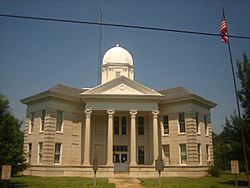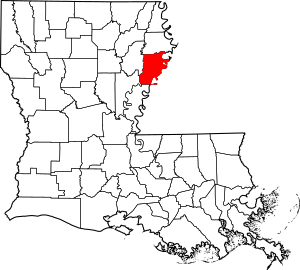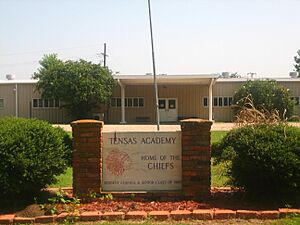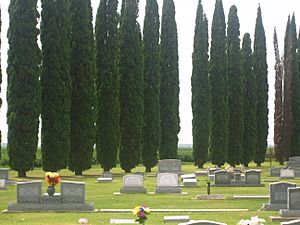Tensas Parish, Louisiana facts for kids
Quick facts for kids
Tensas Parish
|
|
|---|---|

Tensas Parish Courthouse at St. Joseph
|
|

Location within the U.S. state of Louisiana
|
|
 Louisiana's location within the U.S. |
|
| Country | |
| State | |
| Founded | March 17, 1843 |
| Named for | Taensa people |
| Seat | St. Joseph |
| Largest town | Newellton |
| Area | |
| • Total | 641 sq mi (1,660 km2) |
| • Land | 603 sq mi (1,560 km2) |
| • Water | 38 sq mi (100 km2) 6.0% |
| Population
(2020)
|
|
| • Total | 4,147 |
| • Density | 6.470/sq mi (2.4979/km2) |
| Time zone | UTC−6 (Central) |
| • Summer (DST) | UTC−5 (CDT) |
| Congressional district | 5th |
Tensas Parish (French: Paroisse des Tensas) is a special type of county called a parish in the northeastern part of Louisiana. Its eastern border is the famous Mississippi River. In 2020, about 4,147 people lived here, making it the least populated parish in Louisiana.
The main town and government center is St. Joseph. The name "Tensas" comes from the Taensa people, a Native American group who lived here long ago. The parish was officially started in 1843. For a long time, growing cotton was the main way people made a living. Later, some people also raised cattle and cut down trees for wood.
Contents
History
Ancient Times
Long before Europeans arrived, many different Native American groups lived in Tensas Parish. They built villages and large earth mounds. These sites are now important places for archaeologists to study.
One example is the Flowery Mound near St. Joseph. It's a rectangular platform mound about 10 feet (3 meters) tall. It measures 165 feet (50 meters) by 130 feet (40 meters) at its base. Scientists have studied the mound and found that it was built in one go. Charcoal found nearby shows people lived there between 996 and 1162 AD. The mound itself was built later, between 1200 and 1541 AD. Other ancient mound sites in the parish include Balmoral Mounds, Ghost Site Mounds, and Sundown Mounds.
Civil War Era
During the American Civil War, people in Tensas Parish helped the Southern side. Rich farmers, especially cotton growers, paid for and supplied soldiers. For example, A. C. Watson spent over $40,000 on an artillery company.
In April 1862, the governor of Louisiana ordered all cotton to be burned. This was to stop Union (Northern) forces from taking it. Thousands of cotton bales burned for days along the river and on top of old Native American mounds. Tensas Parish was one of the biggest cotton producers in Louisiana at that time.
Near Newellton is the Winter Quarters Plantation. Union General Ulysses S. Grant and his soldiers stayed here during the winter of 1862-1863. They were preparing for a big attack on Vicksburg, Mississippi, which is northeast of Tensas Parish.
In 1864, a Confederate captain named Joseph C. Lea led 200 men into Tensas Parish. They attacked a Union fort and forced the soldiers to leave. Lea's men took supplies like gunpowder and food. They also captured 75 wagons and cotton carts, sending them to Shreveport.
Many beautiful homes were located around Lake St. Joseph. One of the most elegant was Franklin Plantation. Union soldiers were supposed to protect property. However, when General William Tecumseh Sherman's troops arrived, they started burning buildings. On May 6, 1863, most of the mansions along Lake St. Joseph were burned down.
Towards the end of the war, schools were started for African American children in this area. These schools were often supported by groups like the American Missionary Association. By the early 1900s, St. Joseph had about 720 residents. Most people still worked in cotton farming or river-related jobs.
Voting Rights and Schools
Before 1964, almost no African Americans were registered to vote in Tensas Parish. It was the last parish in Louisiana to allow them to register. After the Voting Rights Act of 1965 was passed, many African Americans registered to vote. This changed the politics of the parish a lot.
For a long time, schools in Tensas Parish were separated by race by law. In 1970, this separation officially ended. However, many white students started going to private schools like Tensas Academy. Most African American students continued to attend public schools. Because of this, the public schools still mostly have African American students. Some public high schools in the parish have closed due to fewer students. Today, Tensas High School in St. Joseph is the main public high school.
Local Government and Population Changes
Tensas Parish has seen its population decrease over the years. Between 2006 and 2007, the parish lost 173 residents. This was about 2.9% of its population. Some people had moved there after Hurricane Katrina in 2005. However, many young people leave the parish because there are not enough high-paying jobs. The parish also has many older residents.
Tensas Parish has a main cemetery called Legion Memorial. It was started in 1943 and is located north of Newellton.
Geography
Tensas Parish covers a total area of 641 square miles (1,660 square kilometers). About 603 square miles (1,560 square kilometers) is land, and 38 square miles (98 square kilometers) is water. This means about 6% of the parish is covered by water.
St. Joseph is located right next to the Mississippi River levee system. Levees are walls built to prevent floods.
There are three main towns in the parish: Newellton, St. Joseph, and Waterproof. Newellton was founded by John David Stokes Newell, Sr., and named after his father. All three towns are connected by Highway 65. This highway runs just west of each town. Lake Bruin State Park is a popular spot near St. Joseph. Lake Bruin is an oxbow lake. This type of lake forms when a bend in a river gets cut off from the main flow.
Main Roads
Neighboring Areas
Tensas Parish shares borders with several other parishes and counties:
- Madison Parish (north)
- Warren County, Mississippi (northeast)
- Claiborne County, Mississippi (east)
- Jefferson County, Mississippi (east)
- Adams County, Mississippi (southeast)
- Concordia Parish (south)
- Catahoula Parish (southwest)
- Franklin Parish (west)
Protected Natural Areas
- Tensas River National Wildlife Refuge (part of it is in the parish)
Communities
Towns
- Newellton
- St. Joseph (This is the parish seat, where the main government offices are)
- Waterproof
Small Communities (Unincorporated)
Population Information
| Historical population | |||
|---|---|---|---|
| Census | Pop. | %± | |
| 1850 | 9,040 | — | |
| 1860 | 16,078 | 77.9% | |
| 1870 | 12,419 | −22.8% | |
| 1880 | 17,815 | 43.4% | |
| 1890 | 16,647 | −6.6% | |
| 1900 | 19,070 | 14.6% | |
| 1910 | 17,060 | −10.5% | |
| 1920 | 12,085 | −29.2% | |
| 1930 | 15,096 | 24.9% | |
| 1940 | 15,940 | 5.6% | |
| 1950 | 13,209 | −17.1% | |
| 1960 | 11,796 | −10.7% | |
| 1970 | 9,732 | −17.5% | |
| 1980 | 8,525 | −12.4% | |
| 1990 | 7,103 | −16.7% | |
| 2000 | 6,618 | −6.8% | |
| 2010 | 5,252 | −20.6% | |
| 2020 | 4,147 | −21.0% | |
| U.S. Decennial Census 1790–1960 1900–1990 1990–2000 2010 |
|||
2020 Census Details
| Race | Number | Percent |
|---|---|---|
| White (not Hispanic) | 1,728 | 41.67% |
| Black or African American (not Hispanic) | 2,232 | 53.82% |
| Asian | 6 | 0.14% |
| Pacific Islander | 1 | 0.02% |
| Other/Mixed | 113 | 2.72% |
| Hispanic or Latino | 67 | 1.62% |
In 2020, there were 4,147 people living in Tensas Parish. There were 1,792 households and 1,102 families.
Education
Public schools in Tensas Parish are managed by the Tensas Parish School Board. This board has seven members who are elected by the people.
The Tensas Gazette Newspaper
Tensas Parish has its own weekly newspaper called The Tensas Gazette. It started in 1871 as The North Louisiana Journal and changed its name in 1886. About 1,300 copies are printed every Wednesday and shared throughout the parish.
A man named Josiah Scott took over the newspaper in 1894 when he was 20. He later bought it in 1906 and was the editor until he passed away in 1953. After him, Paul Alexander Myers Jr. and his wife Patricia Wilds owned the paper. Mrs. Myers continued to run it until she retired in 1988.
Today, The Tensas Gazette is owned by Louisiana State Newspapers, Inc. It used to be in downtown St. Joseph but now shares space with the arts council. It is located at 118 Arts Drive, near the Tensas Parish Civic Center.
Famous People from Tensas Parish
Many interesting people have connections to Tensas Parish:
- De'Vante Demond Martin grew up in St. Joseph. He became a television reporter for KNOE 8 News and an Army Reserve sergeant.
- Henry Watkins Allen was a general in the Confederate Army and a governor of Louisiana. Before the war, he grew cotton near Newellton.
- Daniel F. Ashford (1879–1929) was a state representative and a planter. He was the first person in Tensas Parish to own a car and a wristwatch!
- Andrew Brimmer was the first African American to be appointed to the Federal Reserve Board in Washington, D.C. He was born in Tensas Parish.
- Sharon Renee Brown was Miss Louisiana USA and Miss USA in 1961. She was also Miss Waterproof that same year.
- Buddy Caldwell was a district attorney for this area and later became the attorney general of Louisiana.
- Claire Chennault was famous for leading the "Flying Tigers" in World War II. He lived in Waterproof for a time.
- George Henry Clinton was a chemist and lawyer. He served in both parts of the state legislature.
- Jimmie Davis was a famous singer, songwriter, and governor of Louisiana. He owned a farm in Tensas Parish.
- Sarah Dorsey was an author and helped Jefferson Davis, who was the president of the Confederate States.
- James Albert Noe Sr. was another former governor of Louisiana who owned farm property here.
- J.C. Seaman was a state representative for many years. He helped promote Lake Bruin State Park.
Images for kids
-
Winter Quarters State Historic Site near Newellton
-
Former location downtown in St. Joseph of the weekly newspaper, The Tensas Gazette (established 1886).
-
Flowers Landing Baptist Church, a Southern Baptist congregation at 2302 Louisiana Highway 888 northwest of Newellton, serves a rural clientele.
-
Mississippi River levee road in Tensas Parish near St. Joseph
-
The hay harvest south of Newellton (2016)
See also
 In Spanish: Parroquia de Tensas para niños
In Spanish: Parroquia de Tensas para niños












